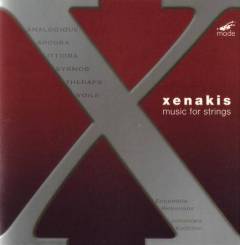Iannis Xenakis – Music For Strings (2005)
Iannis Xenakis – Music For Strings (2005)

1 Syrmos for 18 strings (1959) 12:04
Cello – Cecile Tacier, Maike Reisener Double Bass – Caroline Menke, John Eckhardt
Violin – Andreas Paff, Florian Mausbach, Hyun-Jung Kim, Kamila Namyslowska, Susanne Zapf
2 Aroura for 12 strings (1971) 11:05
Cello – Inga Raab
3 Voile for 20 strings (1995) 5:06
Cello – Inga Raab, Ruslan VilenskyDouble Bass – John EckhardtViolin – Andreas Paff, Wolfgang Bender
4 Theraps for solo contrabass (1975-76) 13:45
Double Bass – John Eckhardt
5 Analogique A+B for 9 strings & tape (1959) 6:46
Cello – Inga Raab, Ruslan VilenskyDouble Bass – John Eckhardt, Tobias Grove
6 Ittidra for string sextet (1996) (8:42)
Viola – Sophie Bansac
Ensemble Resonanz
Johannes Kalitzke – conductor
This CD brings together all of Xenakis' chamber music for strings for the first time (with the exception of the string quartets). The music spans almost 30 years.
- These visceral, sonically bold works explore the many possibilities of writing for strings, including howling glissandi, clustered pizzicatos and tremelos, the clatter of bouncing bows, and a rich palette of dynamics and color.
- The anarchic character of Syrmos alienated Xenakis from the traditional as well as the Darmstadt avant-garde of the 1950s, where it was felt that this music paid no heed to conventional harmony, counterpoint and musical theories -- and even required players to "do violence" to their instruments!
- Performances are by Ensemble Resonanz, one of Germany's leading string ensembles. They are devoted to works of the 20th and 21st centuries, as well as juxtaposing these with a specialty to early music.
Unlike most of his avant-garde contemporaries, Iannis Xenakis did not avoid using strings. And, as Michael Struck-Schloen points out in his informative booklet-note, string timbre provided a direct aural equivalent to the graphic depictions of sound Xenakis used as an alternative to conventional notation. The precedure is vividly demonstrated by Syrmos (1959), with the listner compelled to find a path through dense but exhilarating thickets of tone. It could have been written last year, let alone half a century ago - whereas Analogique A+B (1959) feels wholly of its time, with neither the string component nor its electronic transformation arresting enough to make the amalgram more than a technical exercise.
One of Xenakis's achievements was in evoking a recognizable (thought never traditional) sonic context, against which sound could express itself in directly musical terms. Thus we get the Homeric landscape of Arouta (1971) with its heightened interaction between violent gestures and an even more intense silence, and the transcendental virtuosity of Theraps (1976) - its succession of powerful images redefining the double-bass persona. While not lacking impact, the final piece reflects the creative impasses Xenakis arguably had reached by his last decade. The pungent chordal sonorities of Voiles (1995) and intricate layers of sound compromising Ittidra (1996) feel arrested in time: defiant more out of desperation than conviction.
Much to respond to, then, in these assured performances by Ensemble Resonanz (John Eckhardt a bassist of stature), recorded with an ideal combination of clarity and spaciousness. How about a second disc of string music to feature Shaar, Xenakis's masterpiece in the medium? --- Richard Whitehouse, Gramophone, September 2006
download (mp3 @320 kbs):
yandex 4shared mega mediafire zalivalka cloudmailru uplea








